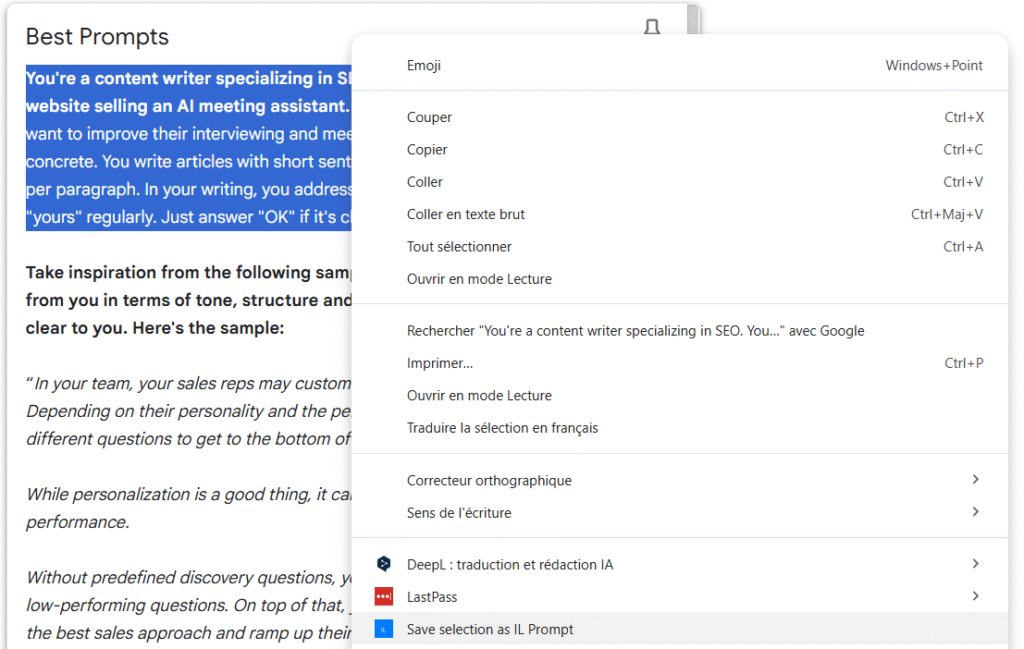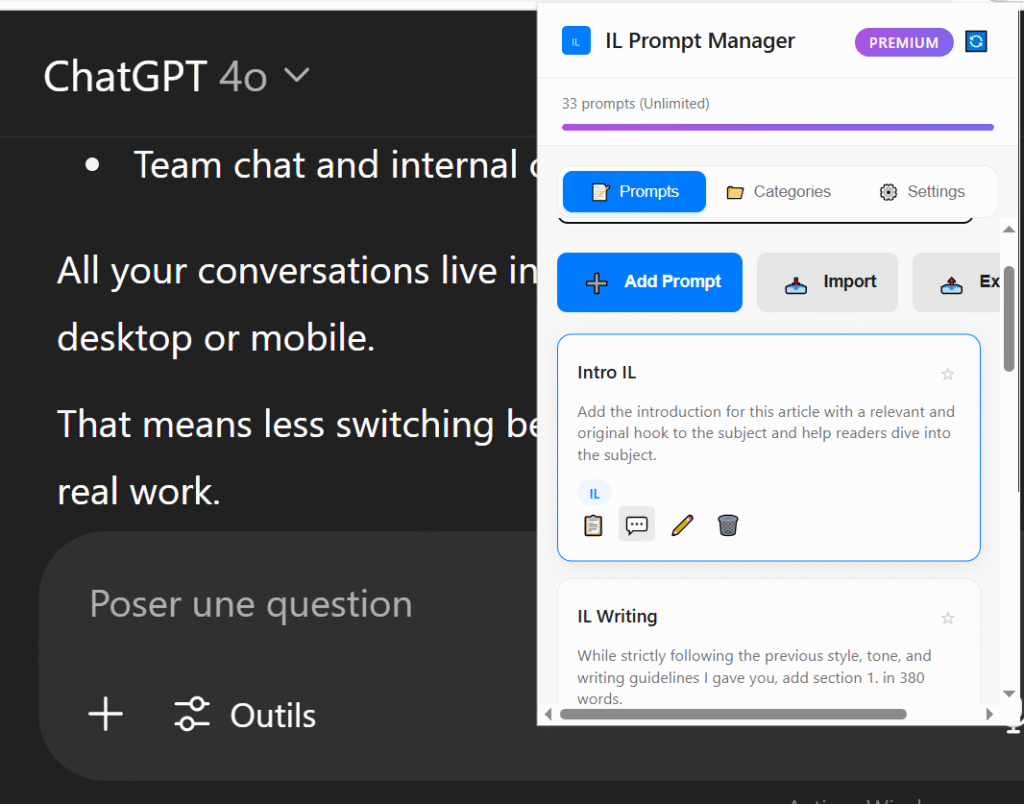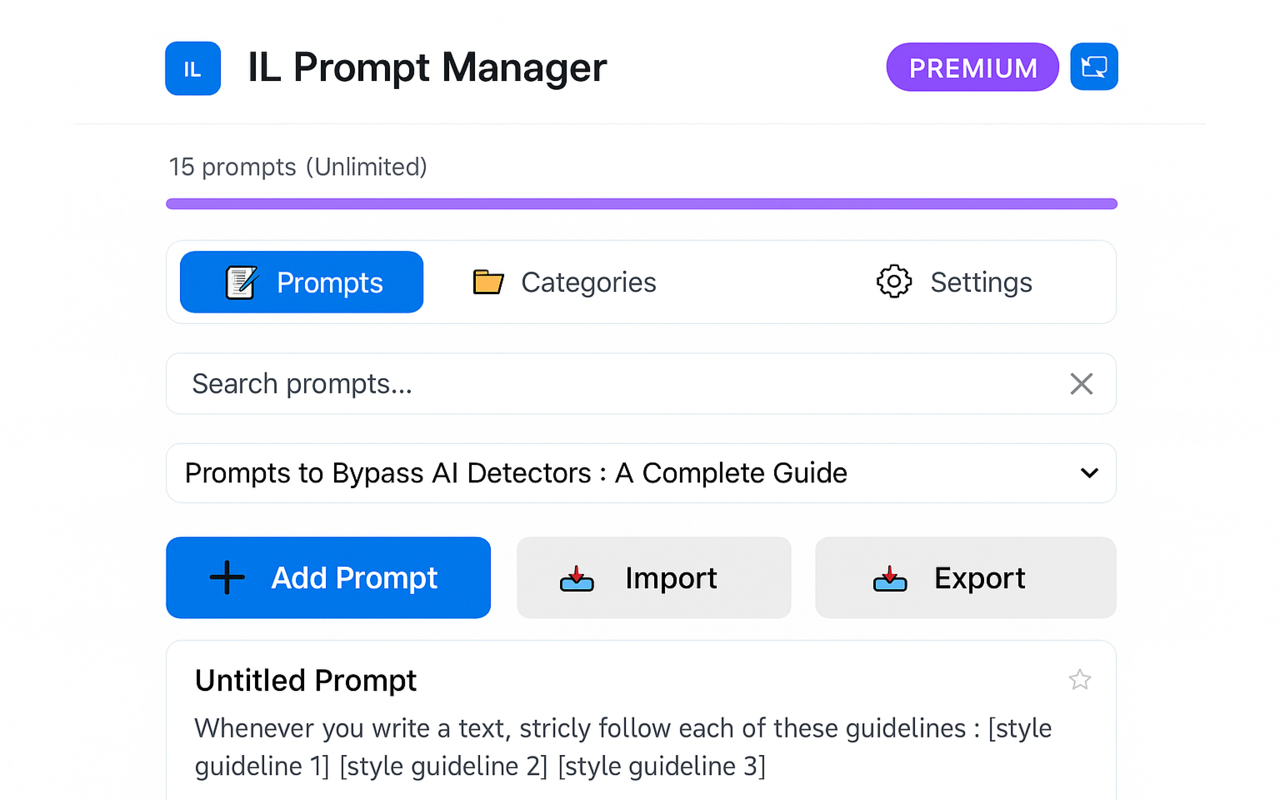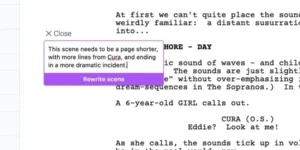The perfect ChatGPT prompts you use are buried in old chats.
The solution? Save your best prompts the moment they work — and organize them so you can use them again, anytime.
In this guide, we’ll show you how to save prompts in ChatGPT.
Is It Possible to Save ChatGPT Prompts?

If you use ChatGPT often, you might found it anoying that there are no easy way to recover prompts. You always have to scroll through long chat threads.
So, can you actually save prompts in ChatGPT?
What ChatGPT Saves by Default
ChatGPT automatically keeps a record of your previous conversations. You’ll find these in the sidebar under your account — listed by time or whatever title the AI guessed for you.
You can click any of those conversations to review your full interaction history: your prompts and ChatGPT’s replies.
But ChatGPT doesn’t let you save or organize individual prompts. You can’t name them, tag them, or easily pull them out of older threads. You’re stuck scrolling or using vague memory to guess where you used that perfect prompt.
Sharing and Exporting Chats
There are a few built-in tools that help, but they’re mostly designed for full conversations — not reusable prompts:
- Share Links: Click “Share” at the top of a chat to get a link you can revisit later or send to someone else.
- Export Chat History: Under Settings → Data Controls → Export, you can download your full chat archive as a file. This contains every conversation, but again, not in a searchable, prompt-specific format.
These tools are better for archiving — not for fast reuse.
How to Save ChatGPT Prompts Manually

If you’re not ready for an extension—or prefer a hands-on approach—you can easily save your favorite ChatGPT prompts manually.
Method 1: Copy-Paste into Documents
The old reliable method—and still one of the most powerful.
- Open your ChatGPT conversation.
- Highlight your prompt and AI response, then copy (
Ctrl+C / Cmd+C). - Paste (
Ctrl+V / Cmd+V) into a document—Word, Google Docs, Notion, or Evernote. - Add a descriptive title, tags, and context notes (e.g., “Blog intro – casual tone, worked well for SaaS post”).
- Save and organize by folder, date, or content type.
✅ Pros: You have total control—structure, comments, backups. Accessible across devices if using cloud docs.
⚠️ Cons: Time-consuming. Easy to lose track if labels aren’t consistent.
Method 2: Share & Bookmark Chat Threads
Use ChatGPT’s built-in tools to save entire conversations with your favorite prompts.
- Share Link: Click “Share” in the chat, copy the link, and save it in a bookmarks folder. You can even title the bookmark for clarity.
- Bookmark Tools: Some extensions let you star or bookmark conversations directly in ChatGPT—ideal if you only want to save a section within a thread.
✅ Pros: Fast, no extra tools needed. Good when you want to revisit entire contexts.
⚠️ Cons: You’ll still need to search manually later. Doesn’t isolate individual prompts.
Method 3: Export Your Chat History
Ideal for creating backups or archiving entire prompt sets.
- Go to Settings → Data Controls → Export.
- Confirm export and wait for an email with your chat history (usually
.zip, withchat.html). - Use browser search (
Ctrl+F) to find prompt snippets in the exported HTML.
✅ Pros: You get a complete, timestamped archive of all your chats.
⚠️ Cons: Bulkier and less prompt-focused—requires manual filtering
The Best ChatGPT Prompt Savers
There are also prompt-saving tools designed to help you. These Chrome extensions and apps are built to help you organize, access, and reuse your best ChatGPT prompts—without switching tabs or copying and pasting.
Let’s start with one of the most effective options out there.
IL Prompt Manager
IL Prompt Manager is a free Chrome extension that turns ChatGPT into a fully equipped prompt workspace. It helps you manage your prompts in real time—right inside the ChatGPT interface.
Key Features
- Centralized Prompt Library
Save all your prompts in one place, neatly organized by category or tag. Think “SEO templates,” “email intros,” “SaaS explainer copy,” and more. A built-in search bar makes finding the right prompt instant. - Seamless ChatGPT Integration
The extension adds a custom panel directly into ChatGPT. Choose a prompt, click once, and it’s loaded into the chat box—ready to go. No tab switching. No time lost. - Save From Anywhere
Found a smart prompt idea in an article? Just highlight the text, right-click, and save it to your prompt library. It works on any website—making it easy to capture inspiration as it comes. - Cloud Sync
Your prompts are stored safely in the cloud. Access them from any device where you’ve installed the extension. No backups or exports needed.
Why It’s a Standout
Unlike some tools that focus on entire conversations, IL Prompt Manager is built specifically for individual prompts. It’s designed for content marketers and creators who write every day and want to scale their workflow without losing quality.
It doesn’t just save your prompts—it keeps your best ideas at your fingertips, so you can build better content, faster.
And yes—it’s 100% free, secure, and easy to use. No logins. No hidden fees. No learning curve.
Other Top Prompt Savers Worth Considering
While IL Prompt Manager offers a complete solution, here are a few alternatives you might explore:
- Superpower ChatGPT – Adds prompt history and favorites to ChatGPT.
- ChatGPT Prompt Plus – Offers prompt templates and preset variables.
- BookmarkGPT – Lets you star and save your favorite prompts for quick access.
- Promptheus Prompt Saver – A simple tool to store text prompts with labels.
These tools vary in features and complexity. Some focus on community-shared prompts, others on private storage.






